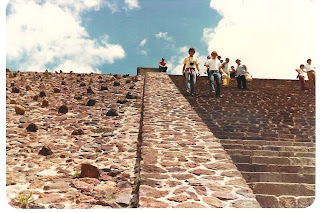Teotihuacán, place of the road to the gods, it seems, located some 40 km north-east of Mexico City, was once the largest city in the American continent. It was built between the 1st and 7th centuries A.D., and reached its zenith between 150 and 450, when it was the centre of a powerful culture that dominated Central America, with an influence comparable to ancient Rome.

"WELCOME - One morning we took a bus tour and went to Teotihuacán. Along the main road of the site - Avenue of the Dead - there are many ceremonial platforms that used to be topped with temples"


"MURALS - Ancient Jaguar Deity at the Palace of the Jaguars and another Jaguar at a site on the plaza of the Moon Pyramid"

"EAGLE"

"PYRAMID OF THE MOON - The 46 meters high Pyramid of the Moon was associated by the Aztecs with the moon and water goddess Chalchiuhtlicue, and is divided into four tiers surmounted by a monumental stairway"

"THE PYRAMID OF THE SUN, 200 meters square and 66 meters high, is the largest building in Teotihuacan and the second largest in the New World after the Great Pyramid of Cholula. It stands atop the sacred cave of creation, and is aligned with the rising of the sun and the appearance of the Pleiades at the spring equinox. It was designed for astronomical observations, worship, and sacrifice, and its four tiers can be climbed by means of a monumental stairway seen on the photo"



"UP THERE - Views of the Pyramid of the Moon, taken from the Pyramid of the Sun"

"CITADELL - Far distance view towards the southern section of the Teotihuacán site"

"ON THE TOP, can you see the guy with the arms open?"


"COMING DOWN"

"MUSEO NACIONAL DE ANTROPOLOGIA - The Museum is located at the Chapultepec Park, which is famous for the Niños Héroes, six military cadets, aged 14-20, who fought to their deaths against the invading United States Marine Corps during the Mexican-American War in 1847. The Museum, opened in 1964, hosts 600,000 art and other objects relating to the country history, some of them being the most significant anthropological finds of Mexico. It's, from my point of view, probably one of the most fabulous museums in the world. In the early morning of December 25, 1985, thieves broke into the National Museum of Anthropology, and made off with 124 priceless pre-Columbian treasures, but in January 1990 most of the items were recovered"



"TEOTIHUACÁN PIECES"

"COATLICUE, also known as Teteo Inan - The Mother of Gods - is the Aztec goddess who gave birth to the moon, stars, and Huitzilopochtli, the god of the sun and war. She is represented as a woman wearing a skirt of snakes and a necklace made of human hearts, hands and skulls"

"LOST MEMORY - I don't know whether this piece was stolen or not. It was attributed to one of the last Aztec emperors, don't know whether Montezuma (who believed that Cortés was Quetzalcoatl) or Cuauhtémoc (the last of the Aztec emperors). I couldn't find any other photo of this..."

"THE AZTEC SUN STONE, a large monolithic sculpture 3.6 meters in diameter, 1.22 meters in thickness and weighing 24 tons, is often mistakenly called the Aztec calendar. It was created by the Mexica people and depicts the four great disasters, which led to the migration of the Mexica to Tenochtitlan, from where it was excavated in the Zócalo, on December 17, 1790. It also contains pictographs depicting the way the Mexica measured time"

"MAYAN STATUE?"


"OUTSIDE PATIO of the Museum"

No comments:
Post a Comment